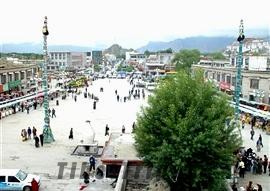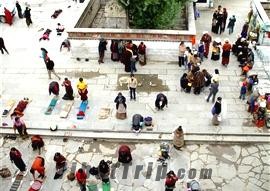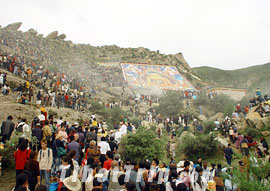
In Tibet, religious observance is not restricted to only the many monks and nuns, but it is also part of the daily life of the ordinary people. Due to the deep and wide influence of Buddhism, the Tibetans conduct practically everything in close accordance with the religious teachings so as to ensure their well being.
 Religious concerns for the newly born
Religious concerns for the newly born
The Tibetans believe that a new baby is born into suffering, so the baptism ceremony is a must for them. Usually on the third day after the baby is born (4th for girls), their friends and relatives will visit with chang (a kind of wine made from a local grain), Yak Butter Tea and some gifts. First of all they reverently present Khatag to the parents and the baby, and then propose a toast to the parents and give them the gifts. Following that they admire the baby and say some propitious words for the family. Some villagers will also place a small quantity of Tsamba (a kind of food) onto the baby's forehead as an auspicious wish for its good health and progress.
A month after the baby is born, he will be dressed anew and taken outside by the family. They will go to worship in the temple first and then visit some relatives or friends considered lucky. Usually some soot from the bottom of a cooking pot will be applied to the tip of the baby's nose, to prevent him from being recognized by evil spirits.
As to the baby's name, usually the parents will take the baby to a Living Buddha (Rinpoche) or a high lama in one of the temples with Khatag and some offerings. The name that is given will be one chosen from Buddhism or the title of the living Buddha or high lama. The name can be changed later if the child is ever subject to misfortune of any kind. In the past, in the case of an upper class child, the Living Buddha cut off a small cluster of hair from the top of the baby's head as a sign of his ordination. Some respected old people in the village are also often invited to name the baby. Such ceremonies are less religious and also follow the will of the parents.
 Circumambulation
Circumambulation
Circumambulation is an important part of Tibetans' life. It can also accumulate merits for them in the same way as reciting sutras. Completing one circle is said to equal reciting a sutra once. So it is common to see a Tibetan circumambulate around sacred mountains, holy lakes, temples, mandalas , mani stones , stupas and other sacred places.

The most common way of circumambulation is rotating prayer wheels by hand, which are inscribed with mantras and have rolls of sutras stored inside. This is easy and can be conducted everywhere they go. Larger prayer wheels line the passages of the Assembly Hall in temples for worshipers to spin as they pass by them.
To circumambulate Mt. Kailash , the main peak of the sacred Gangdise range, is the greatest wish of Tibetans. It is believed that completing one circuit of the mountain can atone for all the sins in one's lifetime, 10 circuits will ensure freedom from hell and damnation and 100 circuits can make a believer immediately at one with Buddha.
 Worship
Worship
As a devout people, Tibetans worship everything containing images of Buddhas and Bodhisattvas. So temples and stupas, some sculptures and paintings are always the holy to them. Many houses are designed with a shrine to contain statues and paintings. The first Yak Butter Tea of the day will be an offering placed before the image of Buddha every morning.
Tibetan Buddhists consider many mountains and lakes to be sacred places. It is customary to prostrate themselves when worshipping as a sign of reverence. White is the holy color and these include the religious symbols and sites like stupas, mani stones, the white conch, prayer flags , Khatag, etc.
 Presenting Khatag
Presenting Khatag
It is a common etiquette that can be used in festivals, at weddings, and other happy events as well as funeral ceremonies, worship, communication and welcoming or seeing off guests.
Khatag is generally a long piece of white silk scarf which expresses good wishes, greetings or consolation of the giver. When presenting khatag, the giver should hold it up high to the shoulder, bow and pass it forward to the recipient, who will accept it with both hands. Only the most respected can hang the Khatag directly around the recipient's neck. The five-colored Khatag (blue, white, red, green, yellow), said to be the costume of Bodhisattva, is the most valuable and can only be presented to Bodhisattva and close relatives for special use.

 Religious Etiquettes and Taboos
Religious Etiquettes and Taboos
Apart from the etiquettes of presenting Khatag and kowtowing at worship, there are also other points that need notice.
![]() Life is precious to the Tibetans and killing is taboo. Beef and mutton are the only meats accepted by them. Other meats are only very rarely eaten. Fish is also forbidden in some areas. It is wrong to try and persuade a Buddhist to eat forbidden foods.
Life is precious to the Tibetans and killing is taboo. Beef and mutton are the only meats accepted by them. Other meats are only very rarely eaten. Fish is also forbidden in some areas. It is wrong to try and persuade a Buddhist to eat forbidden foods.
![]() Be reverent to the three jewels of Buddhism – Buddha, dharma and Sangha. Profane behavior in a temple is strictly forbidden, so please don't touch or move the statues, offerings, religious weapons, paintings or sutras. Be respectful toward the lamas. Don't be too noisy when visiting.
Be reverent to the three jewels of Buddhism – Buddha, dharma and Sangha. Profane behavior in a temple is strictly forbidden, so please don't touch or move the statues, offerings, religious weapons, paintings or sutras. Be respectful toward the lamas. Don't be too noisy when visiting.
![]() Walk clockwise when passing a temple, stupa, mani stone mound, prayer flag and the similarly sacred spots in Tibet. Prayer wheels are also rotated clockwise.
Walk clockwise when passing a temple, stupa, mani stone mound, prayer flag and the similarly sacred spots in Tibet. Prayer wheels are also rotated clockwise.
![]() Don't become involved in the crowd at sky burial holdings or kill hawks. Accept politely if gifts are given by the master of the burial.
Don't become involved in the crowd at sky burial holdings or kill hawks. Accept politely if gifts are given by the master of the burial.
![]() When lamas sit in meditation, usually a board or mud pie is put in front of the door, with a cypress branch stuck in it and some small stones sprinkled around. So please don't set foot inside when seeing this signal. Similarly, if you see smoke rising or a branch or piece of red cloth in front of a house, don't enter as some religious activities might be taking place or someone may be sick or giving birth.
When lamas sit in meditation, usually a board or mud pie is put in front of the door, with a cypress branch stuck in it and some small stones sprinkled around. So please don't set foot inside when seeing this signal. Similarly, if you see smoke rising or a branch or piece of red cloth in front of a house, don't enter as some religious activities might be taking place or someone may be sick or giving birth.
![]() In the Tibetan Calendar , a 12 year period is a small cycle. According to Tibetan belief, the anniversary of a person's birth after such a period, such as at the ages of 13, 25, 37, is very essential. They must recite more sutras or do more good to have a calm existence through these years. Also there are some days in a month, like 2nd, 4th, are considered 'dark days'. So please avoid lengthy discussion with them on these days.
In the Tibetan Calendar , a 12 year period is a small cycle. According to Tibetan belief, the anniversary of a person's birth after such a period, such as at the ages of 13, 25, 37, is very essential. They must recite more sutras or do more good to have a calm existence through these years. Also there are some days in a month, like 2nd, 4th, are considered 'dark days'. So please avoid lengthy discussion with them on these days.








